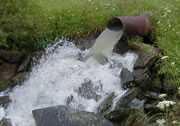Freshwater Quality

According to the United Nations’ World Water Development Report, each year, tons of heavy metals, solvents, toxic sludge, and other accumulated wastes from industrial production get into freshwater supplies. The report also states that in some developing countries, 70 percent of industrial wastes are dumped untreated into streams and rivers, where they pollute drinking water (1). Water that is released back into the environment is called effluent.
The United States Environmental Protection Agency (EPA) issues industrial water pollution control regulations, also called effluent guidelines and standards, for industrial water discharges to surface waters and publicly owned treatment works. These guidelines, issued under the Clean Water Act, prevent more than 700 million pounds of pollutants from discharging into U.S. waters each year. An overview of the guidelines, including information on history, planning, implementation and compliance is available at EPA’s Effluent Limitations Guidelines webpage. Some of the 56 industries covered include: rubber manufacturing, sugar processing, petroleum refining, textile mills, coal mining, dairy products manufacturing, with four additional industry categories currently under development (drinking water treatment, airport de-icing, construction and development, and chlorine and chlorinated hydrocarbon use). To view a complete list of these categories visit EPA’s Effluent Limitations Guidelines: Industry Regulations page.
References
- Schroeder, B. Industrial Water Use. Available at http://academic.evergreen.edu/g/grossmaz/SCHROEBJ/.
- Page last reviewed: October 11, 2016
- Page last updated: October 11, 2016
- Content source:


 ShareCompartir
ShareCompartir